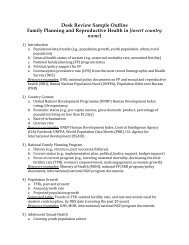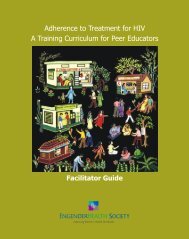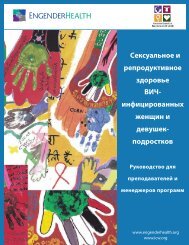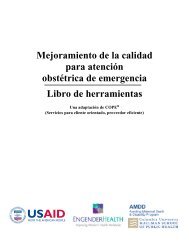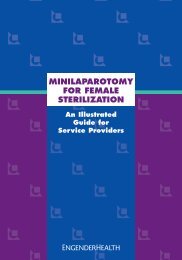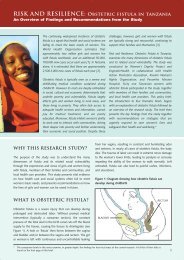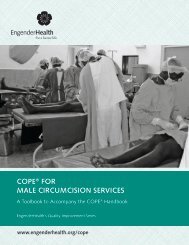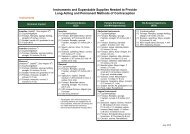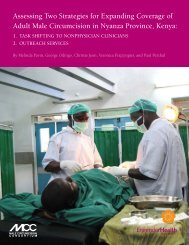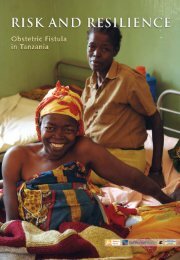Help-Seeking Pathways and Barriers for ... - EngenderHealth
Help-Seeking Pathways and Barriers for ... - EngenderHealth
Help-Seeking Pathways and Barriers for ... - EngenderHealth
Create successful ePaper yourself
Turn your PDF publications into a flip-book with our unique Google optimized e-Paper software.
at large, <strong>and</strong> (potential) perpetrators, which can serve as an effective prevention method as<br />
well as an improvement in the response to GBV.<br />
As part of the sensitization ef<strong>for</strong>t, structured guidance about how to support survivors will<br />
need to be provided to family members, who are usually the first line of help. This<br />
sensitization ef<strong>for</strong>t should be linked to wider violence prevention initiatives. To encourage<br />
the sustainability of activities that target social norms, implementing partners should<br />
consider identifying influential individuals or local groups already working to promote<br />
awareness about health, rights, <strong>and</strong> social issues. These champions could then be trained<br />
<strong>and</strong> fostered to disseminate more gender-equitable ideas <strong>and</strong> messages relevant to the<br />
prevention of <strong>and</strong> adequate response to gender-based violence. Groups that might be<br />
targeted include Village Social Services Committees, CBOs, relevant faith-based groups,<br />
youth <strong>and</strong> peer educator groups, <strong>and</strong> other civil society actors. Given the powerful influence<br />
of stigma on decisions to report violence <strong>and</strong> seek help, it will also be important <strong>for</strong><br />
prevention <strong>and</strong> response ef<strong>for</strong>ts to intentionally incorporate ef<strong>for</strong>ts to reduce stigma against<br />
women who experience GBV. Important lessons can be learned from HIV-related stigma<br />
reduction initiatives <strong>and</strong> research conducted by ICRW. 28<br />
B. Address Structural <strong>Barriers</strong> to <strong>Help</strong>-<strong>Seeking</strong> by Survivors of GBV<br />
This study also identified numerous structural barriers that frequently serve as<br />
insurmountable obstacles to both seeking <strong>and</strong> receiving care <strong>for</strong> GBV. Chief among these<br />
are the distance required to obtain services, the multiplicity of steps in the help-seeking<br />
pathway, <strong>and</strong> corruption. In order to improve upon <strong>and</strong> eliminate these barriers, it is<br />
recommended that the GBV programming of GoT agencies <strong>and</strong> PEPFAR implementing<br />
partners focuses on three priorities:<br />
Bringing services closer to survivors;<br />
Reducing the number of steps in the help-seeking process; <strong>and</strong><br />
Eliminating corruption <strong>and</strong> bribery from the service provision system.<br />
Recommended strategies under each of these priorities, all of which would dramatically<br />
improve women’s access to services <strong>and</strong> support after experiences of GBV are listed below.<br />
Implicit in all recommendations is the need to ensure that services <strong>and</strong> sites throughout the<br />
referral chain are appropriate <strong>and</strong> responsive to the needs <strong>and</strong> realities of women<br />
experiencing violence.<br />
28 Several publications on these models <strong>and</strong> lessons learned can be found on www.icrw.org by searching the<br />
library <strong>for</strong> the keyword “stigma.”<br />
<strong>Help</strong>-<strong>Seeking</strong> <strong>Pathways</strong> <strong>and</strong> <strong>Barriers</strong> <strong>for</strong> Survivors of GBV in Tanzania March 2013<br />
Page 55




